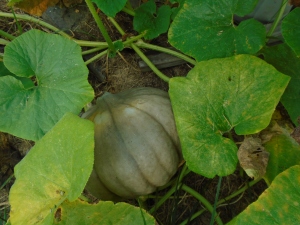Priscilla Hayes
The title of this post is the question that Shanyn Siegel asked us at the start of our most recent Seed Saving class at Duke Farms, a session that was entitled “Garden Smarter: Vegetable Varieties for Gardeners.” Two of my fellow class members offered as favorites the Brandywine tomato (there may have been another part to the name) and a Rattlesnake bean (again, there may have been another qualifier, but this is what I got in my notes). I mentioned the Principe Borghese tomato, which I grow almost exclusively, because I try to dry a lot of tomatoes each year.
Most people didn’t offer a favorite, which went to the point Shanyn was trying to make, which is that most of us don’t pay attention to vegetable varieties. Who hasn’t seen packets of seeds, she asked, in the big box stores, that say simply “Eggplant,” as though there were only one variety.
Large national seed companies try to offer seeds that will grow pretty well anywhere in the country. But the same variety of plant doesn’t do equally well in all places, and the trick is to find something that is well suited to your own climate and growing conditions—for instance, here in New Jersey we have a fairly short growing season, high humidity, and lots of disease pressure.
But even more than place, you will need to determine whether what you are going to grow is well suited to your personal needs as a gardener. If you didn’t think you had personal needs as a gardener, it is helpful to review some of the questions that Shanyn suggested at the class: are there times in your gardening life when you don’t or can’t get into your garden for a week or so, and thus don’t weed, or water, or feed, or harvest? Then you need to be looking for plants that will stand the neglect of whatever period you anticipate giving them. Then there is the question of how are you going to use the produce—Shanyn likes things she can munch in the garden, or use with a minimum of prep, rather than things that require a lot of cooking before use. Do you want things to mature all at once, so you can do a big harvest production like canning, or do you want things to come in a few at a time, so you can use them over a longer period of time, similarly a few at a time. Do they store well, and is this important to you—red onions are tastier for salads and other similar uses, but don’t keep as well as white or yellow onions.
Flavor is perhaps the most personal thing, and this is where you are really going to have to be guided by your own experimentation. And, as has become obvious to me, and hopefully you, you are going to have to keep records of what you grew, and how it did for you, other than just recording “grew eggplant.”
CORNELL UNIVERSITY VEGETABLE VARIETIES FOR GARDENERS
There was a lot more to learn at this class, and like all the classes in this series, it has been a really eye-opening experience, and so obvious once you get it. But Shanyn went on to introduce us all to an online resource she wanted us all to start using, the Cornell University Vegetable Varieties for Gardeners site. Here you can read reviews of vegetable varieties from real-life gardeners who have grown the same vegetable variety you may be contemplating. Most useful, of course, will be reviews from others in your geographic area or under otherwise similar gardening conditions.
For many vegetables, there are not many reviews, which is why Shanyn wants everyone to start putting in lots of feedback, so we will all have more to draw on. For example, the most reviewed vegetable variety, Sungold Tomatoes (which I ate at our seed garden and now HAVE to grow) has only 98 reviews to date—interestingly it is not the site’s top rated variety, or even in the top five.
To get started, you create a garden profile and name for your garden; the profile includes your name, etc., your garden experience level, and then your garden’s location, frost free days (that needed a call to the local Extension office; I note that another local gardener does have a different estimate), soil texture and sun exposure.
I looked up Uncle David’s Dakota Dessert Squash, which I had gotten only as a substitute for a pumpkin that was out of stock, but which was growing in an exuberant fashion before someone ran off with our developing squashes from one of my more open school gardens. There weren’t any New Jersey reviews, so of course, I am planning to add one, assuming I manage to keep any squash through maturity as a winter squash, without it disappearing with someone who thinks it is a summer squash.
MYSTERY SQUASH
Speaking of squashes, as in many years past, I am growing “mystery squash” in my garden—on a plant that has erupted out of the compost bin and sprawled across the front of a couple of garden beds. I have observed that the plants behind it seem less nibbled on than similar plants elsewhere in the garden, leading me to believe that the Native Americans were right when they thought it would give some protection against animal moochers in their Five Sisters gardens. I attach two photos of the squash and a flower—note the bump on the bottom of the squash, rather than a flat pumpkin-like bottom that you might expect from such a pumpkin like squash. Any ideas out there on what variety I am growing?

